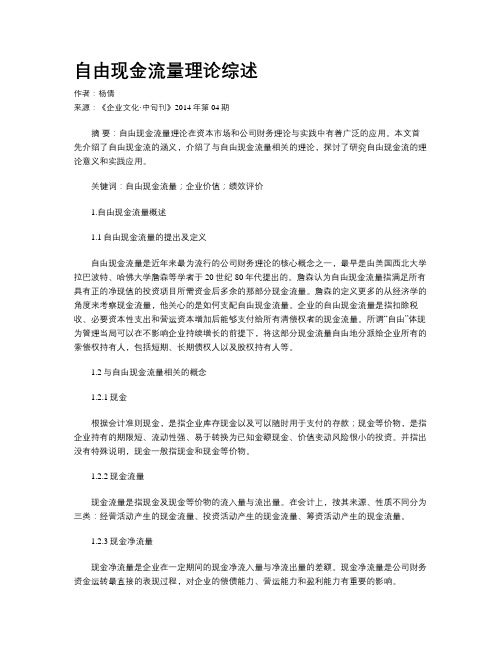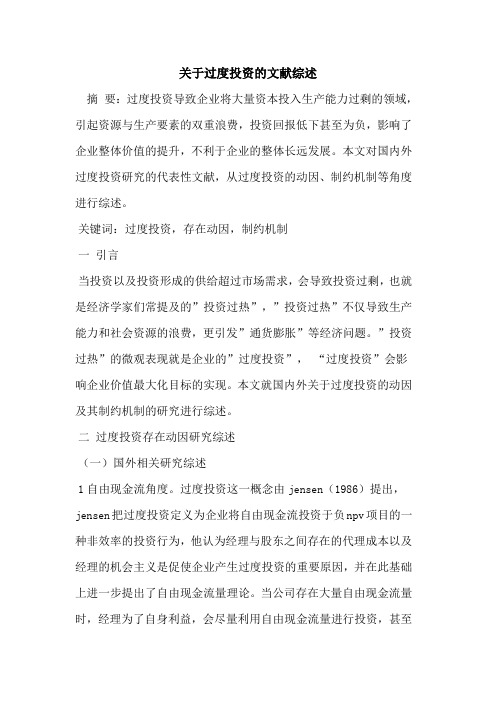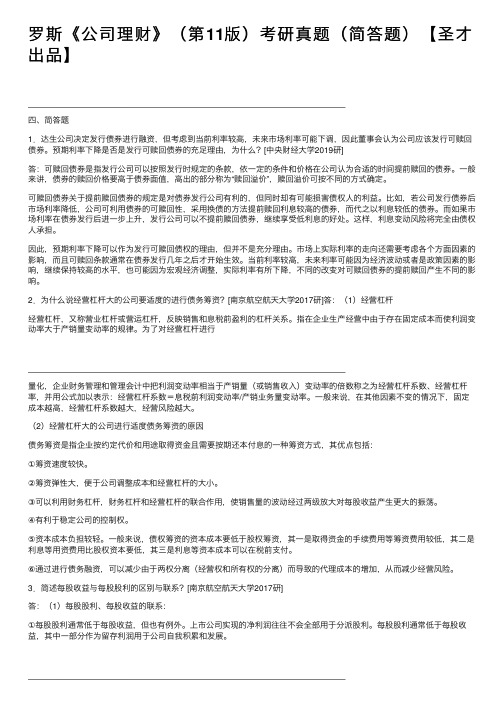自由现金流下的过度投资【外文翻译】
- 格式:doc
- 大小:298.50 KB
- 文档页数:14


自由现金流量理论综述作者:杨倩来源:《企业文化·中旬刊》2014年第04期摘要:自由现金流量理论在资本市场和公司财务理论与实践中有着广泛的应用。
本文首先介绍了自由现金流的涵义,介绍了与自由现金流量相关的理论,探讨了研究自由现金流的理论意义和实践应用。
关键词:自由现金流量;企业价值;绩效评价1.自由现金流量概述1.1自由现金流量的提出及定义自由现金流量是近年来最为流行的公司财务理论的核心概念之一,最早是由美国西北大学拉巴波特、哈佛大学詹森等学者于20世纪80年代提出的。
詹森认为自由现金流量指满足所有具有正的净现值的投资项目所需资金后多余的那部分现金流量。
詹森的定义更多的从经济学的角度来考察现金流量,他关心的是如何支配自由现金流量。
企业的自由现金流量是指扣除税收、必要资本性支出和营运资本增加后能够支付给所有清偿权者的现金流量。
所谓“自由”体现为管理当局可以在不影响企业持续增长的前提下,将这部分现金流量自由地分派给企业所有的索偿权持有人,包括短期、长期债权人以及股权持有人等。
1.2与自由现金流量相关的概念1.2.1现金根据会计准则现金,是指企业库存现金以及可以随时用于支付的存款;现金等价物,是指企业持有的期限短、流动性强、易于转换为已知金额现金、价值变动风险很小的投资。
并指出没有特殊说明,现金一般指现金和现金等价物。
1.2.2现金流量现金流量是指现金及现金等价物的流入量与流出量。
在会计上,按其来源、性质不同分为三类:经营活动产生的现金流量、投资活动产生的现金流量、筹资活动产生的现金流量。
1.2.3现金净流量现金净流量是企业在一定期间的现金净流入量与净流出量的差额。
现金净流量是公司财务资金运转最直接的表现过程,对企业的偿债能力、营运能力和盈利能力有重要的影响。
1.2.4净自由现金流量净自由现金流量等于自由现金流量减去利息、其他融资成本以及税费。
1.2.5自由现金流量假说及其两个推论自由现金流量假说将由现金资源支配权引起的代理问题称作自由现金流量代理问题。

自由现金流自由现金流自由现金流(Free Cash Flow)作为一种企业价值评估的新概念、理论、方法和体系,最早是由美国西北大学拉巴波特、哈佛大学詹森等学者于20世纪80年代提出的,经历20多年的发展,特别在以美国安然、世通等为代表的之前在财务报告中利润指标完美无瑕的所谓绩优公司纷纷破产后,已成为企业价值评估领域使用最广泛,理论最健全的指标,美国证监会更是要求公司年报中必须披露这一指标。
自由现金流量,就是企业产生的、在满足了再投资需要之后剩余的现金流量,这部分现金流量是在不影响公司持续发展的前提下可供分配给企业资本供应者的最大现金额。
简单地说,自由现金流量(FCF)是指企业经营活动产生的现金流量扣除资本性支出(Capital Expenditures,CE)的差额。
即:FCF=CFO-CE。
自由现金流是一种财务方法,用来衡量企业实际持有的能够回报股东的现金。
指在不危及公司生存与发展的前提下可供分配给股东(和债权人)的最大现金额。
[1]自由现金流在经营活动现金流的基础上考虑了资本型支出和股息支出。
尽管你可能会认为股息支出并不是必需的,但是这种支出是股东所期望的,而且是一现金支付的。
自由现金流等于经营活动现金.[1]资本性支出是指取得的财产或劳务的效益可以给予多个会计期间所发生的那些支出。
因此,这类支出应予以资本化,先计入资产类科目,然后,再分期按所得到的效益,转入适当的费用科目。
在企业的经营活动中,供长期使用的、其经济寿命将经历许多会计期间的资产如:固定资产、无形资产、递延资产等都要作为资本性支出。
即先将其资本化,形成固定资产、无形资产、递延资产等。
而后随着他们为企业提供的效益,在各个会计期间转销为费用。
如:固定资产的折旧、无形资产、递延资产的摊销等。
[1]延伸与资本性支出相对应的是收益性支出,又叫期间费用。
我国《企业会计准则》第二十条规定:“会计核算应合理划分收益性支出与资本性支出。
凡支出的效益与本会计年度相关的,应当作为收益性支出;凡支出的效益与几个会计年度相关的,应当作为资本性支出”,这类支出应予以资本化,先计入资产类科目,然后,再分期按所得到的效益,转入适当的费用科目。

关于过度投资的文献综述摘要:过度投资导致企业将大量资本投入生产能力过剩的领域,引起资源与生产要素的双重浪费,投资回报低下甚至为负,影响了企业整体价值的提升,不利于企业的整体长远发展。
本文对国内外过度投资研究的代表性文献,从过度投资的动因、制约机制等角度进行综述。
关键词:过度投资,存在动因,制约机制一引言当投资以及投资形成的供给超过市场需求,会导致投资过剩,也就是经济学家们常提及的”投资过热”,”投资过热”不仅导致生产能力和社会资源的浪费,更引发”通货膨胀”等经济问题。
”投资过热”的微观表现就是企业的”过度投资”,“过度投资”会影响企业价值最大化目标的实现。
本文就国内外关于过度投资的动因及其制约机制的研究进行综述。
二过度投资存在动因研究综述(一)国外相关研究综述1自由现金流角度。
过度投资这一概念由jensen(1986)提出,jensen把过度投资定义为企业将自由现金流投资于负npv项目的一种非效率的投资行为,他认为经理与股东之间存在的代理成本以及经理的机会主义是促使企业产生过度投资的重要原因,并在此基础上进一步提出了自由现金流量理论。
当公司存在大量自由现金流量时,经理为了自身利益,会尽量利用自由现金流量进行投资,甚至不惜投资于净现值为负值的项目中扩大企业规模以便从中获取各种私人利益及在职消费。
vogt(1994)认为经理的机会主义可以用于解释那些规模较大而股利水平不高的企业中存在的过度投资行为。
harford(1999)、bates(2005)、richardson(2006)等学者进行实证检验,结果也证实了jensen提出的观点。
2信息不对称角度。
myers(1984)、myers and majluf(1984)将不对称信息理论引入企业投资行为的分析中,认为当外部投资者和内部经营者之间对企业投资项目的预期现金流收益方面存在着信息不对称时,资本市场上的投资者对企业因实施该投资项目而发行的融资证券的估值会产生偏差,若这一偏差表现为高估就会导致企业投资决策中过度投资的发生。

罗斯《公司理财》(第11版)考研真题(简答题)【圣才出品】四、简答题1.达⽣公司决定发⾏债券进⾏融资,但考虑到当前利率较⾼,未来市场利率可能下调,因此董事会认为公司应该发⾏可赎回债券。
预期利率下降是否是发⾏可赎回债券的充⾜理由,为什么?[中央财经⼤学2019研]答:可赎回债券是指发⾏公司可以按照发⾏时规定的条款,依⼀定的条件和价格在公司认为合适的时间提前赎回的债券。
⼀般来讲,债券的赎回价格要⾼于债券⾯值,⾼出的部分称为“赎回溢价”,赎回溢价可按不同的⽅式确定。
可赎回债券关于提前赎回债券的规定是对债券发⾏公司有利的,但同时却有可能损害债权⼈的利益。
⽐如,若公司发⾏债券后市场利率降低,公司可利⽤债券的可赎回性,采⽤换债的⽅法提前赎回利息较⾼的债券,⽽代之以利息较低的债券。
⽽如果市场利率在债券发⾏后进⼀步上升,发⾏公司可以不提前赎回债券,继续享受低利息的好处。
这样,利息变动风险将完全由债权⼈承担。
因此,预期利率下降可以作为发⾏可赎回债权的理由,但并不是充分理由。
市场上实际利率的⾛向还需要考虑各个⽅⾯因素的影响,⽽且可赎回条款通常在债券发⾏⼏年之后才开始⽣效。
当前利率较⾼,未来利率可能因为经济波动或者是政策因素的影响,继续保持较⾼的⽔平,也可能因为宏观经济调整,实际利率有所下降,不同的改变对可赎回债券的提前赎回产⽣不同的影响。
2.为什么说经营杠杆⼤的公司要适度的进⾏债务筹资?[南京航空航天⼤学2017研]答:(1)经营杠杆经营杠杆,⼜称营业杠杆或营运杠杆,反映销售和息税前盈利的杠杆关系。
指在企业⽣产经营中由于存在固定成本⽽使利润变动率⼤于产销量变动率的规律。
为了对经营杠杆进⾏量化,企业财务管理和管理会计中把利润变动率相当于产销量(或销售收⼊)变动率的倍数称之为经营杠杆系数、经营杠杆率,并⽤公式加以表⽰:经营杠杆系数=息税前利润变动率/产销业务量变动率。
⼀般来说,在其他因素不变的情况下,固定成本越⾼,经营杠杆系数越⼤,经营风险越⼤。

⾃由现⾦流⽂献综述⽂献综述摘要企业的⾃⾝价值作为投资者的主要参考依据,投资者会根据⼀个企业的价值来判断该企业是否值得被投资,企业也会因为其⾃⾝价值是否充分的被投资者所认识⽽作出相应的公司发展策略,⽽⾃由现⾦流作为⼀种企业价值评估的理论、⽅法和体系,最早是由美国西北⼤学拉巴波特和哈佛⼤学詹森等学者在20世纪80年代所提出来的,它是衡量企业价值的重要指标,研究⾃由现⾦流模型评估企业价值,旨在站在投资者的⾓度,运⽤模型分析出,被评估企业是否值得投资,其企业价值是否与市场价值所契合(有⽆被⾼估或是低估)。
并通过真实的价值反映,帮助企业实现价值最⼤化,改善企业管理⽔平落后的状况,为企业作出的决策提供更加坚实的基础依据,投资者通过分析⼀家公司的⾃由现⾦流量来分析该公司是否有投资价值。
关键词:⾃由现⾦流企业价值FCFE FCFF⽬录前⾔ (1)⼀、⾃由现⾦流的定义与计算 (2)(⼀)⾃由现⾦流的定义 (2)(⼆)⾃由现⾦流的计算 (2)⼆、⾃由现⾦流估值模型 (3)(⼀)FCFE模型 (4)(⼆)FCFF模型 (6)(三)CFF公式的形成原理 (7)三、总结 (9)参考⽂献 (10)前⾔近年来,随着我国市场经济体制的初步建⽴和改⾰开放的推进,出现了多种所有制经济的交融发展,企业并购的数量不断增多,规模也不断扩⼤。
在企业并购过程中,⽆论是收购公司还是⽬标公司都要对被收购⽬标公司进⾏价值评估,从⽽得到⾃⼰⼼⽬中的价位,合理的价格是决定交易能否成功的关键。
与国外发达的价值评估体系相⽐,我国企业价值评估起步较晚。
20年代80年代末期,我国引⼊了资产评估的概念、原理和⽅法,同步引⼊了企业价值评估和实物资产评估。
虽然当时也引⼊了“企业的价值不等于企业资产价值简单加和”的观点与理论。
但在我国长期的企业价值评估实务中,这样的理念并没有得到实际执⾏,我国企业价值评估和实物资产评估始终混在⼀起,不予区分。
随着经济全球化和⼀体化进程的加快,资产重组以空前的规模和速度进⾏。
g y,p Agency Costs of Free Cash Flow, Corporate Finance and Takeovers——Michael C. Jensen 1986《美国经济评论》——Michael C Jensen1986自由现金流的代理成本,公司财务与收购论文背景:从20世纪60年代到20世纪80年代,美国石油行业经历了从繁荣到衰败的转折,这是自由现金流量假说最直接的背景。
美国石油行业从20世纪60年代末开始出现繁荣景象,利用积累的大量现金进行了广泛的投资活动,然而由于管理者的自私动机,直接导致了1975~1985年间投资项目的大量失败,股价也持续下跌。
为了研究这一问题,Jensen发表了这篇文章,第一次提出了自由现金流(Free Cash Flow)的概念,以及如何解决自由现金流的代理成本。
论文提纲1. 重要概念与研究目的2. 债务在激励组织有效性中的角色3.3. 财务重组中的证据4. 杠杆收购和私有化交易的证据5. 来自石油行业的证据6石油行业的收购6.7. 收购的自由现金流理论自由现金流是指满足所有具有正的净现值的投自由现金流,是指满足所有具有正的净现值的投资项目(NPV>0)所需资金后多余的那部分现金流量,这些投资项目的净现值按相关资本成本贴现计算出来。
企业现有资金万元100万元,A 项目需资金50万元(NPV>0),B项目需资金30万元(NPV>0),C 项目需资金10万元(NPV<0)。
满足项目A(50万元)B 30满足项目(万元)20自由现剩余现金(万元)金流股东VS经理人股东:应当将自由现金流以现金股利或者股票回购等股东应当将自由现金流以现金股利或者股票回购等方式支付给股东,防止经理人将其投资于低于资本成本的活动或将其浪费在组织的低效率运行中。
经理层:把自由现金流留存在企业中。
1增加经理层所控制的资源增加其权力加速企1.增加经理层所控制的资源,增加其权力。
控股股东代理问题、现金股利与权益资本成本罗琦;彭梓倩;吴哲栋【摘要】本文基于控股股东代理问题的视角分析现金股利分配对权益资本成本的影响,并探讨这种影响在控股股东特征不同的公司中所呈现出的差异.本文以股权分置改革后2006-2011年沪、深两市A股上市公司为样本进行实证检验,发现公司支付现金股利能够显著降低权益资本成本,并且这一效果在控股股东为非国有股东以及终极控股股东两权分离的公司中表现得更为显著.本文的研究结果表明,现金股利能够作为一种有效的公司治理机制缓解控股股东代理问题,从而使得公司权益资本成本下降.%Based on the perspective of agency problems between controlling and minority shareholders,this paper investigates the influence of companies` cash dividend distribution on the cost of equity capital,and discusses the effects on companies under different characteristics of controlling ing a sample of Chinese listed companies in Shanghai and Shenzhen stock exchanges from 2006 to 2011,the empirical results show that cash dividend distribution may decline the cost of equity capital.Moreover,such weakening effect is stronger when the controlling shareholder is non-state-controlled or in the companies with the separation of control rights and cash flow rights.The study indicates that cash dividends can be used as an effective internal governance mechanism to alleviate the agency problem between controlling shareholders and minority shareholders,which will result in a decline of the cost of equity capital.【期刊名称】《经济与管理研究》【年(卷),期】2017(038)005【总页数】9页(P125-133)【关键词】控股股东;代理问题;现金股利;权益资本成本【作者】罗琦;彭梓倩;吴哲栋【作者单位】武汉大学经济与管理学院,武汉市,430072;武汉大学经济与管理学院,武汉市,430072;武汉大学经济与管理学院,武汉市,430072【正文语种】中文【中图分类】F275.3在完美资本市场中,投资者可以通过自制股利的方式实现资本利得与现金股利的完全替代,股利政策与公司资本成本无关[1]。
2022年注册会计师《财务成本管理》试题及答案(新版)1、[单选题]下列各项中不属于利润中心的考核指标的是()。
A.部门边际贡献B.分部经理可控边际贡献C.部门可控边际贡献D.可控的销售收入【答案】D【解析】利润中心的考核指标通常为该利润中心的部门边际贡献、分部经理可控边际贡献和部门可控边际贡献。
2、证券投资风险分为系统风险和非系统风险,下列各项中属于系统风险的有( )。
A.新产品开发失败的风险B.通货膨胀的风险C.利率的变动的风险D.失去重要销售合同的风险【答案】BC【解析】新产品开发失败的风险和失去重要销售合同风险属于非系统风险。
3、下列各项中,属于固定制造费用“三因素分析法”下的差异的有()。
A.耗费差异B.能量差异C.效率差异D.闲置能量差异【答案】ACD【解析】本题的主要考查点是固定制造费用三因素分析法下的成本内容。
固定制造费用三因素分析法是将固定制造费用的成本差异分为耗费差异、效率差异和闲置能量差异3部分。
4、根据代理理论,下列关于资本结构的表述中,正确的有( )。
A.在债务合同中引入限制性条款将增加债务代理成本B.当企业自由现金流相对富裕时,提高债务筹资比例,有助于抑制经理层的过度投资行为C.当企业陷入财务困境时,股东拒绝接受净现值为正的新项目将导致投资不足问题D.当企业陷入财务困境时,股东选择高风险投资项目将导致债权人财富向股东转移的资产替代问题【答案】BCD【解析】在债务合同中引入限制性条款将增加债务代理收益,选项A错误;当企业自由现金流相对富裕时,提高债务筹资比例,增加了债务利息固定性支出在自由现金流量中的比例,实现对经理的自利性机会主义行为的制约,选项B正确;当企业陷入财务困境时,股东如果预见采纳净现值为正的新投资项目会以牺牲自身利益为代价补偿债权人,股东就缺乏积极性投资该项目,将导致投资不足问题,选项C正确;当企业陷入财务困境时,股东选择高风险投资项目提高了债务资金的实际风险水平,降低了债务价值,这种通过高风险项目的过度投资实现把债权人的财富转移到股东手中的现象被称为“资产替代问题”,选项D正确。
自由现金流下的过度投资【外文翻译】-CAL-FENGHAI-(2020YEAR-YICAI)_JINGBIAN自由现金流下的过度投资【外文翻译】本科毕业论文(设计)文翻译外原文:Over-investment of free cash flowAbstractThis paper examines the extent of firm level over-investment of fre cash flow. Using an accounting-based framework to measure over-investment and free cash flow, I find evidence that, consistent with agencycost explanations, over-investment is concentrated in firms with the highest levels of free cash flow. Further tests examine whether firms’ governance structures are associated with over-investment of free cash flow. The evidence suggests that certain governance structures, such as the presence of activist shareholders, appear to mitigate over-investment.IntroductionThis paper examines firm investing decisions in the presence of free cash flow. In theory, firm level investment should not be related to internally generated cash flows (Modigliani & Miller, 1958). However, prior research has docu-mented a positive relation between investment expenditure and cash flow ., Hubbard, 1998). There are two interpretations for this positive relation. First, the positive relation is a manifestation of an agency problem, where managers in firms with free cash flow engage in wasteful expenditure ., Jensen 1986; Stulz 1990). When managers’objectives differ from those of shareholders, the presence of internallygenerated cash flow in excess of that required to maintain existing assets in place and finance new positive NPV projects creates the potential for those funds to be squandered. Second, the positive relation reflects capital market imperfections, where costly externalfinancing creates the potential for internally generated cash flows to expand the feasible investment opportunity set ., Fazzari, Hubbard, & Petersen, 1988; Hubbard, 1998).This paper focuses on utilizing accounting information to better measure the constructs of free cash flow and over-investment, thereby allowing a more powerful test of the agency-based explanation for why firm level investment is related to internally generated cash flows. In doing so, this paper is the first to offer large sample evidence of over-investment of free cash flow. Prior research, such as Blanchard, Lopez-di-Silanes, and Vishny (1994), document excessive investment and acquisition activity for eleven firms that experience a large cash windfall due to a legal settlement, Harford (1999) finds using a sample of 487 takeover bids, that cash-rich firms are more likely to make acquisitions that subsequently experience abnormal declines in operating performance, and Bates (2005) finds for a sample of 400 subsidiary sales from 1990 to 1998 that firms who retain cash tend to invest more, relative to industry peers. This paper extends these small sample findings by showing that over-investment of free cash flow is a systematic phenomenon across all types of investment expenditure.The empirical analysis proceeds in two stages. First, the paper uses an accounting-based framework to measure both free cash flow and over-investment. Free cash flow is defined as cash flow beyond what is necessary to maintain assets in place and to finance expected new investments. Over-investment is defined as investment expenditure beyond that required to maintain assets in place and to finance expected newinvestments in positive NPV projects. To measure over-investment, I decompose total investment expenditure into two components: (i) required investment expenditure to maintain assets in place, and (ii) new investment expenditure. I then decompose new investment expenditure into over-investment in negative NPV projects and expected investment expenditure, where the latter varies with the firm’s growth opportunities, financing constraints, industry affiliation and other factors.Under the agency cost explanation, management has the potential to squander free cash flow only when free cash flow is positive. At the other end of the spectrum, firms with negative free cash flow can only squander cash if they are able to raise “cheap” capital. This is less likely to occur because these firms need to be able to raise financing and thereby place themselves under the scrutiny of external markets(DeAngelo, DeAngelo, & Stulz, 2004; Jensen, 1986). Consistent with the agency cost explanation, I find a positive association between over-investment and free cash flow for firms with positive free cash flow. For a sample of 58,053 firm-years during the period 1988–2002, I find that for firms with positive free cash flow the average firm over-invests 20% of its free cash flow. Furthermore, I document that the majority of free cash flow is retained in the form of financial assets. The average firm in my sample retains 41% of its free cash flow as either cash or marketable securities. There is little evidence that free cash flow is distributed to external debt holders or shareholders.Finding an association between over-investment and free cash flow is consistent with recent research documenting poor future performance following firm level investment activity. For example, Titman, Wei, and Xie (2004) and Fairfield, Whisenant, and Yohn (2003) show that firms with extensive capital investmentactivity and growth in net operating assets respectively, experience inferior future stock returns. Furthermore, Dechow, Richardson, and Sloan (2005) find that cash flows retained within the firm (either capitalized through accruals or “invested” in financial assets) are associated with lower future operating performance and future stock returns. This performance relation is consistent with the over-investment of free cash flows documented in this paper.The second set of empirical analyses examine whether governance structures are effective in mitigating over-investment. Prior research has examined the impact of a variety of governance structures on firm valuation and the quality of managerial decision making (see Brown & Caylor, 2004; Gompers, Ishii, & Metrick, 2003; Larcker, Richardson, & Tuna, 2005 for detailed summaries). Collectively, the ability of cross-sectional variation in governance structures to explain firm value and/or firm decision making is relatively weak. Consistent with this, I find evidence that out of a large set of governance measures only a few are related to over-investment. For example, firms with activist shareholders and certain anti-takeover provisions are less likely to over-invest their free cash flow.1. Free cash flow and over-investmentThis section describes in detail the various theories supporting a positive relation between investment expenditure and cash flow and then develops measures of free cash flow and over-investment that can be used to test the agency based explanation. . Explanations for a positive relation between investment expenditure and cash flow .In a world of perfect capital markets there would be no association between firm level investing activities and internally generated cash a firm needed additional cash to finance an investment activity it would simply raise that cash from external capital thefirm had excess cash beyond that needed to fund available positive NPV projects (including options on future investment) it would distribute free cash flow to external markets. Firms do not, however, operate in such a are a variety of capital market frictions that impede the ability of management to raise cash from external capital markets. In addition,there are significant transaction costs associated with monitoring management to ensure that free cash flow is indeed distributed to external capital equilibrium,these capital market frictions can serve as a support for a positive association between firm investing activities and internally generated cash flow.The agency cost explanation introduced by Jensen (1986) and Stulz (1990) suggests that monitoring difficulty creates the potential for management to spend internally generated cash flow on projects that are beneficial from a management perspective but costly from a shareholder perspective(the free cash flow hypothesis).Several papers have investigated the implications of the free cash flow hypothesis on firm investment activity. For example, Lamont (1997) and Berger andHann (2003) find evidence consistent with cash rich segments cross-subsidizing more poorly performing segments in diversified firms. However, the evidence in these papers could also be consistent with market frictions inhibiting the ability of the firm to raise capital externally and not necessarily an indication of over-investment.Related evidence can also be found in Harford (1999) and Opler, Pinkowitz, Stulz, and Williamson (1999, 2001). Harford uses a sample of 487 takeover bids to document that cash rich firms are more likely to make acquisitions and these “cash rich” acquisitions are followed by abnormal declines in operating performance. Opler et al.(1999) find some evidence that companies with excess cash (measured using balance sheet cash information) have higher capital expenditures, and spend more onacquisitions,even when they appear to have poor investment opportunities (as measured by Tobin’s Q). Perhaps the most direct evidence on the over-investment of free cash flow is the analysis in Blanchard et al. (1994). They find that eleven firms with windfall legal settlements appear to engage in wasteful expenditure.Collectively,prior research is suggestive of an agency-based explanation supporting the positive relation between investment and internally generated cash flow. However, these papers are based on relatively small samples and do not measure over-investment or free cash flow ,the findings of earlier work may not be generalizable to larger samples nor is it directly attributable to the agency cost explanation. More generally, a criticism of the literature examining the relation between investment and cash flow is that finding a positive association may merely indicate that cash flows serve as an effective proxy for investment opportunities ., Alti, 2003).My aim is to better measure the constructs of free cash flow and over-investment by incorporating an accounting-based measure of growth opportunities, and test whether the relation is evident in a large sample of firms.Some early work in this area examined the sensitivity of investment to cash flow for high versus low dividend paying firms (Fazzari et al., 1988),comparing differing organizational structures where the ability to raise external financing was easier/harder (Hoshi,Kashyap and Scharfstein,1991,with Japanes keiretsu firms) and debt constraints (Whited, 1992).These papers find evidence of greater sensitivity of investment to cash flow for sets of firms which appeared to be financially constrained., low dividend paying firms, high debt firms and firms with limited access to banks). However, more recent research casts doubt on the earlier results. Specifically, Kaplan and Zingales (1997, 2000), find that the sensitivity of investment to cash flowpersists even for firms who do not face financing constraints. They construct a measure of ex ante financing constraints for a small sample of firms and find that the sensitivity of investment to cash flow for firms is negatively associated with this measure,thereby casting doubt on the financing constraint hypothesis. Nonetheless the investment expectation model described in Section includes a variety of measures designed to capture financing constraints.ConclusionThis paper presents evidence on firm level over-investment of free cash flow. The empirical analysis utilizes an accounting based framework to measure the constructs of free cash flow and comparative advantage of theaccounting researcher is in measuring critical constructs from the financial economics analysis of over-investment and free cash flow is but one example of how accounting information can be better utilized in academic research. The evidence in this paper suggests that over-investment is a common problem for publicly traded US firms. For non-financial firms during the period 1988–2002, the average firm over-invests 20 percent of its available free cash flow. Furthermore, the majority of free cash flow is retained in the form of financial assets. For each additional dollar of free cash flow the average firm in the sample retains 41 cents as either cash or marketable securities. There is little evidence that free cash flow is distributed to external stakeholders, thereby creating the potential for retained free cash flow to be over-invested in the future. Supplemental analysis found only weak evidence that governance structures are effective in mitigating the extent of over-investment.These findings corroborate recent work that has found significant negative future stock returns from capital investment and significant growth in net operatingassets .,Fairfield et al.,2003;Titman et al., 2004).Indeed,Li (2004) finds that future operating performance is lower for firms engaging in investment expenditure and that this negative relation is increasing in contemporaneous free cash natural explanation for this poor future performance is free cash flow related agency costs.The framework developed in the paper to measure over-investment and free cash flow can easily be extended to consider abnormal investment more generally. Indeed, some recent research has started to use this framework to examine the impact of accounting information systems on investment decisions and the efficient allocation of capital ., Bushman, Piotroski, & Smith, 2005; Goodman, 2005; Wang, 2003).Source: Scott Richardson,2006.“Over-investment of free cash flow” .Review ofAccount Studies,, june,.译文:自由现金流下的过度投资摘要本文调查了公司水平范围内的自由现金流的过度投资问题。